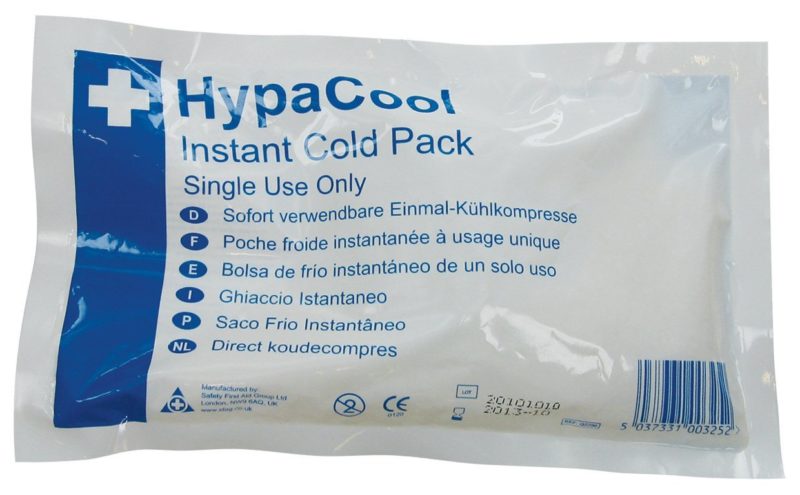
Applying ice or heat can provide relief from injuries, aches, and pains, but they shouldn’t be used interchangeably. Generally speaking, ice works well after a sudden injury while heat helps to soothe ongoing muscle aches and pains.
Cold
Cold works for injuries because it narrows your blood vessels, which helps prevent blood from accumulating at the site of injury, which will add to inflammation and swelling while delaying healing. This is also why elevation is helpful; it limits blood flow to the area to minimize swelling.
During immediate treatment, the aim is to limit the body’s response to injury. Ice will:
- Reduce bleeding into the tissues.
- Prevent or reduce swelling (inflammation).
- Reduce muscle pain and spasm.
- Reduce pain by numbing the area and by limiting the effects of swelling.
- These effects all help to prevent the area from becoming stiff, by reducing excess tissue fluid that gathers as a result of injury and inflammation.
A good rule of thumb to remember following an injury is RICE: rest, ice, compression, and elevation.
Ideally, ice should be applied within 5-10 minutes of injury and for 20-30 minutes. You don’t want to use ice longer than this as it could damage your skin or even lead to frostbite. This can be repeated every 2-3 hours or so whilst you are awake for the next 24-48 hours. You’ll want to protect your skin from direct exposure by applying a cloth or towel between your skin and the ice.
Do not use ice packs on the left shoulder if you have a heart condition. Do not use ice packs around the front or side of the neck.
After the first 48 hours, when bleeding should have stopped, the aim of treatment changes from restricting bleeding and swelling to getting the tissues remobilized with exercise and stretching. Ice helps with pain relief and relaxation of muscle tissue.
I bought an ice pocket from Decathlon, and keep ice cubes handy in the freezer to use whenever needed. You can take such bags with you when you play in tournaments, typically the bar at the courts will have some ice if you need to apply cold to a sprain.
I also always take a bag of instant ice with me wherever I play. This guarantees that I will always have ice treatment available whenever I need it.
Studies on Ice and Recovery
There is only marginal evidence of RICE (rest, ice, elevation and compression) improving recovery in injuries.
For example, in a review of 22 studies of ankle injuries, ice and elevation had only marginal effects on recovery.
In another review of six studies in soft tissue injuries, there was no evidence that ice was effective.
In a review of 45 sports medicine textbooks, the advice on the use of ice varied in the textbooks.
Some individual studies such as this one do show evidence for decreased pain and some increased range of motion earlier for ice used in the first 72 hours.
Importantly, studies don’t seem to suggest there is a harm. The short answer, which is often used to guide decisions in medicine, is “Can’t hurt. Might help.”
Personally, I’ve used cold treatment very successfully to bring down heavy swelling caused by contusions such as getting hit by a padel racket (happens more than you think). This is the main benefit I see together with the numbing effect that helps reduce the sensation of pain.
Avoid using ‘Magic Spray’
Magic sprays are mainly used to combat pain resulting from a sports-related collision injury. The “freezing” of the wound allows players to get back in the game.
Not only does the extra cooling help injured players return more quickly to the game, but the more convenient logistics of spraying versus holding an ice pack against your leg means players avoid sitting out the remaining time.
That can lead to additional injuries, as athletes become unaware of what is going on underneath their frozen skin.
The sprays should, therefore, be avoided by amateur players who don’t have access to physios and doctors during matches to evaluate an injury and take the best action.
Cold Immersion
Regular cold water and ice baths, otherwise known as cold-water immersion or “cryotherapy,” is also a popular technique among amateur and professional athletes, as it is thought to help reduce muscle inflammation and pain after exercise, as well as speed recovery time.
Indeed, after analyzing 17 trials involving over 360 people who either rested or immersed themselves in cold water after resistance training, cycling, or running, researchers found the cold-water baths were much more effective in relieving sore muscles one to four days after exercise.
Most studies on cold-water immersion report no or minimal side effects, so if you’re willing to spend 20 minutes or so in a cold tub of water, you may very well find some relief. Of course, common sense must be used. When you immerse yourself in cold water, it will shock your body to some degree, so you need to make sure the water is not too cold and you do not stay in it for too long.
Personally, I’ve never been able to withstand cold water, so while I harbor some hope of eventually acclimatizing to cold immersion gradually, right now I cannot do it.
Heat
Heat is an effective and safe treatment for most aches and pains. Heat can be applied in the form of a wheat bag, heat pads, deep heat cream, hot water bottle or heat lamp.
Heat causes the blood vessels to open wide (dilate). This brings more blood into the area to stimulate healing of damaged tissues. It has a direct soothing effect and helps to relieve pain and spasm. It can also ease stiffness by making the tissues more supple. As blood flow increases, so does the flow of oxygen and nutrients to the area while waste materials are removed.
If heat is applied to the skin it should not be hot; gentle warmth will be enough. If excessive heat is applied there is a risk of burns and scalds. A towel can be placed between the heat source and the skin for protection. The skin must be checked at regular intervals.
Heat also works well for joint pain or as a pre-workout warm-up. I use the Tiger Balm (Red) gel that I also got from Decathlon. It’s fantastic for giving an extra kick in the starting points of the match, when there is the risk of feeling a bit stiff and cold, especially in winter months. I find this especially useful during a tournament when I play several matches a day. After a few hours of waiting between matches, my legs tend to stiffen up and feel less active. The gel really helps give my body a sense of activation and lightness and get me ready for action.
Generally speaking, pain that is chronic and does not involve swelling will respond well to heat treatment. As with ice, you’ll want to use a barrier between the heat and your skin, such as a cloth. Apply the heat for 15 or 20 minutes at a time.
You may also want to try alternating heat and cold, which is a strategy often recommended by physical therapists and trainers. Apply heat for 20 minutes then follow immediately with 20 minutes of cold.
Creams, Gels, Sprays, Ointments – What to Use?
Sprays: Sprays can be excellent for hard-to-reach spots like your back. The spray provides a highly pressurized force of cooling menthol that quickly numbs the pain. The best part about using a spray is that it does not have a messy drip or a greasy feeling. Sprays offer immediate pain relief and so are more helpful in dealing with acute pain like an ankle sprain after an injury. However see my warning above; you need to know what you’re doing.
Creams: Creams are very effective in relieving arthritic pain, but they can only provide temporary relief. Most creams contain counterirritants which can heat the skin and distract the brain from the pain. A common compound capsaicin found in pain-relieving creams block the skin’s pain receptors and thus reduces the pain.
Gels: Gels are a less greasy version of creams and ointments, but they can easily dry out your skin especially if the product is alcohol-based. Most gels contain counterirritants that combine the sensations of cold and hot for a healing relief. Most of these products contain menthol that cools the area and capsaicin that delivers heat to give pain relief for up to eight hours. Gels can be used to relieve shoulder, upper, and lower back pain.
Recommended Creams
The most famous creams are Deep Heat and Deep Freeze. I don’t use those particular ones but use similar ones. I also don’t use sprays for the reasons mentioned earlier; they tend to have very aggressive effects and are easier to abuse during matches when your heart wants you to continue playing but you should be stopping to avoid aggravating an injury.
Deep Heat or similar products should be used as a form of pain relief from muscular aches, pains, and stiffness in areas such as the back or neck; while Deep Freeze or similar should be used for the treatment of joint pain or impact injuries.
The products can, and should, be used at different times if you are still able to exercise, play, or train. As is always the case, your muscles should be warm and loose before you start exercising so Deep Heat muscle rubs and sprays can be used to get the blood flowing; while Deep Freeze can be used afterward to treat any injuries that may have occurred.
Creams I used before exercise
- Tiger Balm Red
Creams I use after exercise
- Ice Power Cold Gel – Spreads easily and gives immediate effects.
- Madform Double Strength – Impressive cold/heat action, but not as easy to spread as Ice Power.
- Fisiocrem – Not as easy to spread as the other two, still not sure if I like it that much. It’s got natural ingredients and a pleasant smell.
What’s your experience with cold and hot therapy?

Thank you for this information, I appreciate your effort, please keep us update.